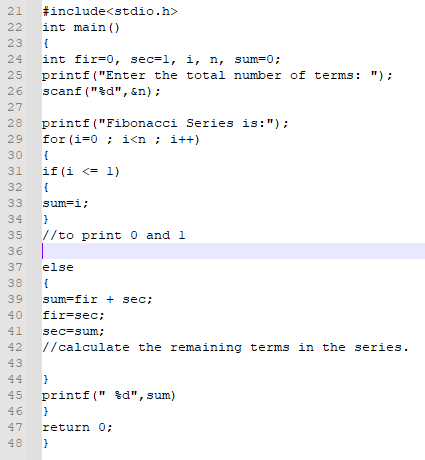Fibonacci Series in C : A Quick Start to C Programming
Fibonacci series is a fun and engaging way to understand multiple concepts of a programming language. In this article, we would explore a quick snippet on how to get started with C and start to experiment with basic concepts. Hope you have the basic setup ready to run a C programming code with any standard IDE. To begin coding any concept, one must first understand what the expected outcome would be and the ways to achieve it. Let us begin by understanding the Fibonacci series in C.

A Fibonacci program in C is formed when you add the preceding two numbers in a number line. Here is an example :
0,1,1,2,3,5,8,13,21….
Now 0+1=1 , 1+1=2, 1+2=3, 2+3=5, 3+5 =8 and so on.
This is the basics of how a Fibonacci series program in C is constructed. The same has to be implemented using C. Let us look at the code snippet and the output and then we would deep dive into the functioning of the code.

The code begins by first declaring all variables and initiating library files. We begin by setting the values for the first and second, then these terms would be used to build the next sequence. After that we declare the number of terms n, this variable holds the length of the sequence. There is also a term to hold the sum of the two numbers called sum. The end term is i, utilized for iteration within the loop.
We will accept the number of terms as in input from the user and save it. We then have a for loop that runs from 0 all the way to the number of terms requested by the user, that is n.
Inside the for loop, we first have an if statement with the condition checking if the value of i if it is less than 1. Depending on the number of terms it checks for 0 or 1 and prints it. This is used to build the initial sequence of the entire series of fibonacci in c.
Also Read:
If the number of terms is more than one, the else part of the loop would run. In this portion, the calculation of the variable first and second is allocated to the variable sum. The next term in line is the additional variable.
In the next portion of the code, we assign the value of the next term to the initial term and after that, the value of the sum to the second term. Using this method the next term the previous two values are changed as a new value gets printed as output. Once the else part is over, we print the sum value. This is accomplished until the value of i becomes equal to n. The loop stops and an exit sequence is initiated.
One can also find if a number is part of the Fibonacci series in C using this snippet. As an example, 4 is not a part of the series whereas 5 is a part. This can be highly effective in use cases like pattern discovery using multiple ML algorithms.
Student Also Liked:
Running code snippets such as these can be highly engaging and can offer good insights into how a basic C code would work out. Once could leverage this knowledge and compare it across programming languages and use cases to build a strong foundation in programming.
Also read Top providers offers C Certification Courses
Articles
Upcoming Exams
Application Date:11 November,2024 - 08 April,2025